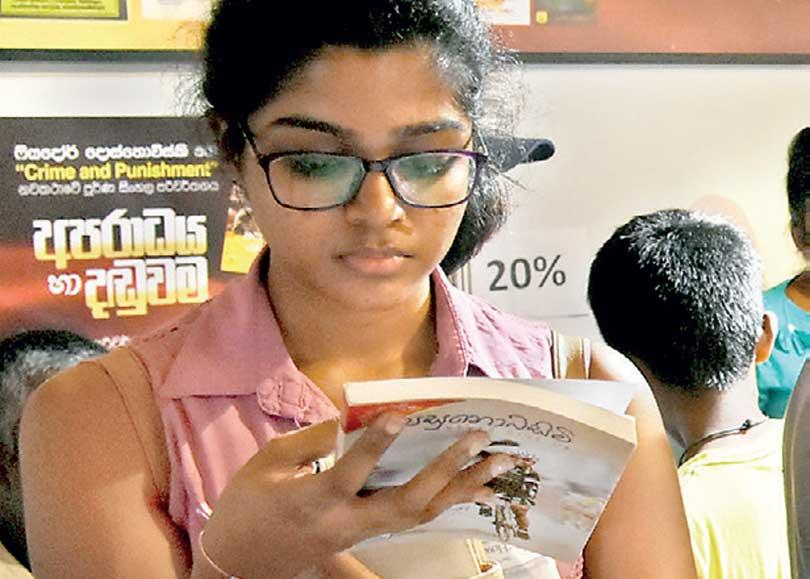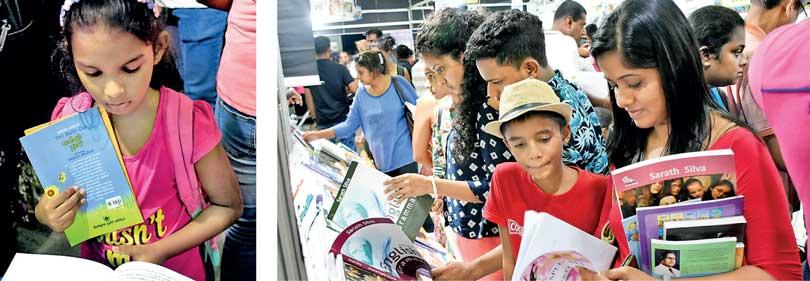Reply To:
Name - Reply Comment


 Sri Lankans love to read. They also love to think they read. And I daresay they want others to think they read too. Either way, they buy books. They may go for the same genres, authors, and publishers, but they buy. Some of them build up massive libraries, others just freely give away what they have, and still others may enter your name in a black book when they lend you, generously of course, those titles you never thought you could get anywhere else. Either way, they are passionate about owning a collection.
Sri Lankans love to read. They also love to think they read. And I daresay they want others to think they read too. Either way, they buy books. They may go for the same genres, authors, and publishers, but they buy. Some of them build up massive libraries, others just freely give away what they have, and still others may enter your name in a black book when they lend you, generously of course, those titles you never thought you could get anywhere else. Either way, they are passionate about owning a collection.
So it is natural, when fairs are around the corner, that they should go en masse to them and make a show about what they buy, how they buy, and why they buy; they even Instagram about it. Many go for the kick of it and end up eating noodles at every spot and buying just one or two books, but then to denounce this, as I do, is to forget that in the 16th century the Frankfurt Book Fair (the oldest of them all) included diversions like musical contests, roper dancers, side shows, drinking bouts, and, as shocking as it seems, gambling and prostitution. And if Edward Jayakody’s anthem for the Colombo Book Fair (composed by him, written by Bandara Eheliyagoda) seems a tad too hagiographic, consider that Henri Estienne, scholar and printer, composed a Latin panegyric on the Frankfurt Fair (“Encomium of the Frankfort Fair”) in 1574. Some things never seem to change. And they should not.
As of today, of course, most Sri Lankans prefer and gravitate to the Colombo Book Fair. This year marks 20 years since it was launched as the Sri Lankan Book Fair at the National Art Gallery and 18 years since it was moved to the BMICH under its present name. The factors that compelled it, the issues that it wades through, and the struggles waged by publishers to woo readers are grist for another article; in this piece I wish to gauge the preferences of those readers and how the Fair tries to meet their expectations.
The first question really revolves around how much you’re willing to cough out. Malinda Seneviratne, in an interview with YA TV back in 2010, admitted he spent about Rs.5,000 a month on books. It’s difficult to ascertain whether this is true of the average Sri Lankan, but my guess is that it is not: according to the most recent report by the Central Bank, of their incomes Sri Lankans tend to spend about 1.8% on recreational and cultural pursuits (which I assume include buying books). This means, with an income of Rs.100,000, the average Sri Lankan has about Rs. 1,800 left for books; according to the HIE Survey of 2016, the average spent in the country on these pursuits was a much lower Rs.908. Given that Rs.5,000 is what we spend at the Fair, spending that amount each month would thus seem more a dream than a reality, though for people like Malinda and me, it is not.
Then it revolves around what you want to spend it on. In the absence of a detailed survey that cuts through, and takes into account, socioeconomic and geographic factors, we have no way of confirming what Sri Lankans like to read the most. Having been to the Fair for the last 10-plus years, if crowd proportions are anything to go by, I’d assume that English-speaking readers tilt more towards teenage romances and adult fiction, and Sinhala speaking readers tilt more towards translations and, more significantly, Swarna Pusthaka nominees.
 In Colombo, unlike Frankfurt and Leipzig (the two biggest book fairs in the world), the event is timed to coincide with a major national literary awards ceremony (the Swarna Pusthaka was inaugurated in 2006); on my way out I came across a group of teenage girls, probably undergraduates, arguing over who had won and who had been nominated in what category at this year’s ceremony. Given the Fair is “synced” with the awards, one can claim it targets the middle class Sinhala speaking population; but then such generalisations are crass.
In Colombo, unlike Frankfurt and Leipzig (the two biggest book fairs in the world), the event is timed to coincide with a major national literary awards ceremony (the Swarna Pusthaka was inaugurated in 2006); on my way out I came across a group of teenage girls, probably undergraduates, arguing over who had won and who had been nominated in what category at this year’s ceremony. Given the Fair is “synced” with the awards, one can claim it targets the middle class Sinhala speaking population; but then such generalisations are crass.
In any case, class divisions and linguistic barriers aren’t too evident at the Fair, and it pretty much reflects the absence of such barriers in the wider reading landscape in the country. On the other hand, however, it’s difficult to spot out Sinhala readers buying an equal number of English books, or English readers buying an equal number of Sinhala (or Tamil) books. It’s true that in terms of genres they are more or less united: their preference for biographies, for instance, is almost universal. But this does not erase away those subtle differences between these two segments, be it economic, cultural, linguistic, or geographic.
The next important question is whether the reading public has evolved, even if their tastes have stayed the same. In 1998, one year before the Fair was begun, Dayawansha Jayakody lamented that he was printing the same number of copies of a new title that he had 20 years earlier; on the other hand, H. D. Premasiri of a reputed bookshop quipped that the “reading habit” had “caught on” and a new author could count himself successful if he had sold 5,000 copies in two or three years. Mr Jayakody caters to a Sinhala speaking public, and Mr Premasiri caters to a Sinhala and English speaking public; their responses may be framed by their markets, though they are both correct: first time writers here take time to catch on.
Sri Lankan readers I know complain about a lack of choice, and they are not wrong; they have been conditioned to go to the same stalls, the same publishers, the same glossy covers when they shop for books. One only has to compare what are on offer at the usual top-notch bookshops to understand they are being fed the same stuff every year. The fault, however, cannot be with publishers and stalls only. If their choice is constrained, so are the choosers: what else can explain the fact that Sri Lankan readers prefer certain genres over others and will virtually abandon places that do not cater to their wants?
Brian Moeran once contested that book fairs are “tournaments of value” removed from the routine of everyday life. While agreeing with him, I would nevertheless suggest that as far as the book fair here is concerned, it is a macrocosm of the general economics of book buying in Sri Lanka: big, glossy titles predominate over less popular topics. This was to be seen even at the Big Bad Wolf: adult fiction, teenage romances, and cookery books sold out like hotcakes, while the history section was much less patronised, even at the time of closing.
I dream of the day Sri Lankans will not be swayed by shiny, glossy covers, but then shiny, glossy covers do make good business sense even if nothing substantive is to be found inside. That’s why and how history sells at these events; it is the coffee table, illustrated volume that predominates over more specialist studies. A massive, lavishly laminated ‘Illustrated History of the World’, for instance, was selling for Rs.5,000 (pretty cheap!); at another stall, Gananath Obeyesekere’s ‘The Buddha in Sri Lanka’ was “auctioned” for about Rs.20,000! The choice is between a rock and a hard place: you buy heavily glossed over accounts of people’s lives and world histories, or you pay a hefty price to read what publications targeting a scholarly crowd churn out. In both cases, the reader loses out. A middle path is thus what he or she should aim at, and here, mercifully, the Colombo Book Fair triumphs.
On average, while the number of foreign participants has remained the same (42 in 2003, 40 this year), the number of local stalls has risen dramatically (158 in 2003, 410 this year). The number of participants has also increased (350,000 in 2004, 1.5 million in 2018) and this may well explain the proliferation of bookstores. It also explains the proliferation of stalls that sell rare books for cheap: A stall of a publisher (the stall staff of which “garland” you with posters of Che Guevara and Fidel Castro before you leave them) sells Marx’s and Engel’s writings for Rs. 400. Another publisher sells ‘The Handbook of the Ceylon National Congress’ for Rs. 775, and the Archaeology Department sells Paranavitana’s Inscriptions of Ceylon for Rs.520. The fact that the latter was neglected (it was patronised mostly by the elderly) tells a lot about where we are and where they ought to be. Yes, we read. But not enough.
